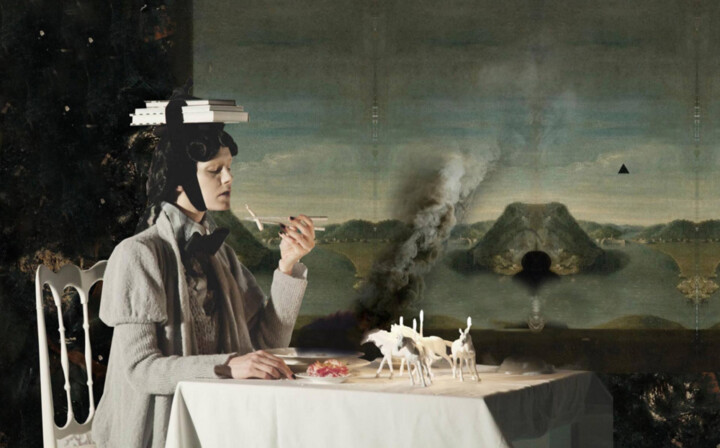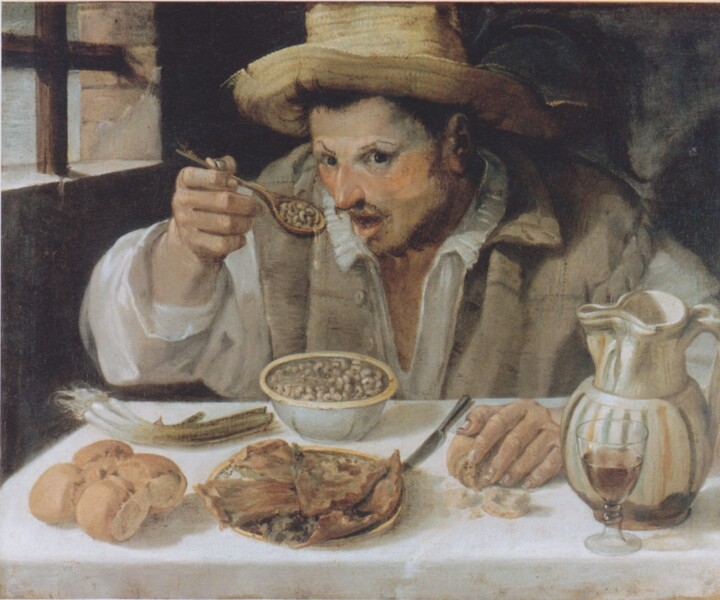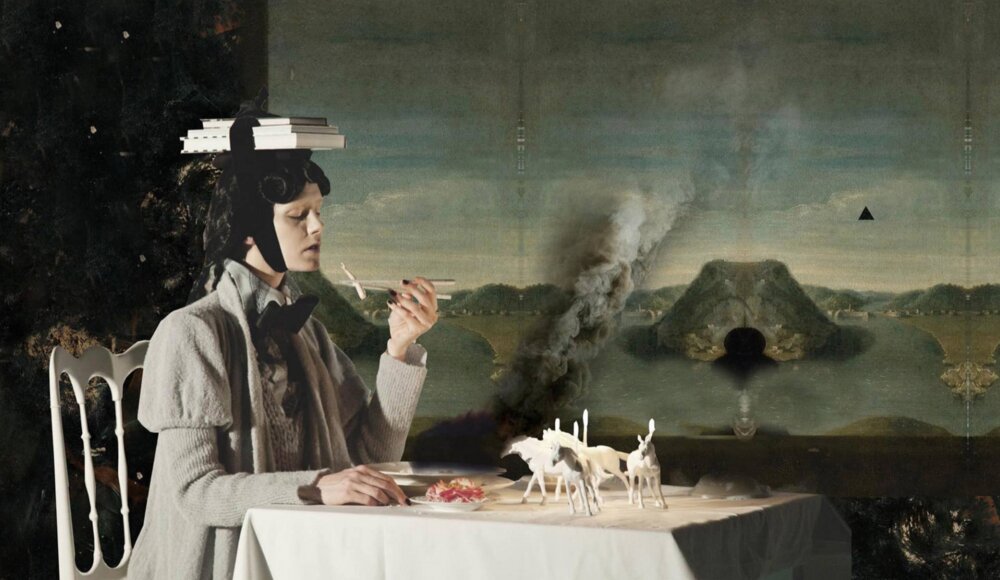 BREAKFAST WITH THE ANIMALS (2015)Painting by Igor Skaletsky.
BREAKFAST WITH THE ANIMALS (2015)Painting by Igor Skaletsky.
From the eyes to the mouth, via the hands....
In the center of the canvas is arranged a realistic woven wicker cenestra, intent on "caring for," as well as "cradling," the roughly twelve specimens of fruit of various kinds, which it jealously guards inside, depicted with the intention of showing them to the viewer, who, in any case, must limit himself only to looking at, and thus without touching or biting into, such a rich banquet of pears, apples, figs, grapes and peaches. In fact, the pictorial fiction just described, making part of the still life genre of Caravaggesque achievement, aimed at assuming the iconic title of Basket of Fruit (1594-1598), demonstrates how, within the narrative of art history, food was, at first, established as a subject exclusively to be contemplated, often avoiding any kind of depiction, which would accommodate within it a more enterprising relationship between man and a succulent dish to be consumed. What has just been stated has been deduced from the fact that the earliest still lifes were even developed in the Hellenistic age, while genre scenes, where subjects caught eating in their dwellings often fall in, did not take hold until the figurative survey of Holland in the first half of the 16th century. At this point, however, a more than legitimate question arises: what about artworks depicting banquets? This subject, prevalent since the earliest civilizations, was created to provide the public with an image of a socialized context within which food and drink is consumed, although it has rarely gone to great lengths to capture subjects actually caught with their mouths open, that is, intent on swallowing delicacies, so much so that, in most cases, it is more likely to see the diners drinking, while their copious plates remain immaculate, to say the least. Therefore, in order to give voice to a realistic and more authentic depiction of the relationship between food and man, I will construct a figurative narrative, which will transform the purest Caravaggesque contemplation, into a practical journey, aimed at bringing food from the market, that is, from the place of supply par excellence, to the mouth of a gluttonous and hungry character, or group of characters. As anticipated above, the first close encounter between man and fruit, fish, meat, etc, preceding the next one, which is far more intimate and savory, could take place in the Vucciria, a well-known historical market in Palermo depicted, in 1974, by the Italian painter Renato Guttuso, who gave life, through a very personal style and point of view, to a narrative aimed at describing buyers moving in the narrow space of the stalls, where the figure of a woman dressed in white stands out, who, proceeding forward, runs into a young man walking in the opposite direction. Finally, the other characters present in the stuff-rich masterpiece are, in addition to other passersby, the vendors, who are mostly employed in arranging, observing and selling their wares. Another place where the more modern, passive activity of procuring food might take place is Annibale Carracci's Bottega del macellaio (Butcher's Shop), a 1585 canvas distinguished by the presence of slaughtered animals hanging from hooks, ready to be expertly cut up and sold by the piece.
 Vincenzo Campi, The Ricotta Eaters, c. 1585. Oil on canvas, 72 cm × 89.5 cm. Museum of Fine Arts of Lyon, Lyon.
Vincenzo Campi, The Ricotta Eaters, c. 1585. Oil on canvas, 72 cm × 89.5 cm. Museum of Fine Arts of Lyon, Lyon.
 Annibale Carracci, Beans Eater, 1584–1585. Oil on canvas, 57×68 cm. Galleria Colonna, Roma.
Annibale Carracci, Beans Eater, 1584–1585. Oil on canvas, 57×68 cm. Galleria Colonna, Roma.
At this point, between the action of buying and eating, a decisive phase imposes itself, namely that in which the food is prepared, to be ready to be chopped up by our teeth, kneaded by our saliva and swallowed to reach the insatiable stomach. Therefore, in order to describe the moment of cooking, cutting, mincing, etc. the delicacies bought at the aforementioned Vucciria, I refer to Two Cooks in the Kitchen by Flemish artist Marten De Vos, a work probably aimed at depicting two cooks intent on preparing the lunch of the rich Epulon. After this last masterpiece we are then ready to illustrate two works, the effigies of which, without any modesty whatsoever, hurl themselves at the food by conspicuously opening their mouths, which happens, for example, in Vincenzo Campi's I mangiatori di ricotta and, though in a much less visceral way, in Annibale Carracci's Mangiafagioli. Speaking of the most explicit of the aforementioned masterpieces, in I mangiatori di ricotta the painter's intention to capture the most typical popular spirit of the peasant tradition, namely that marked by the imposition of spontaneous and vulgar gestures, animated by a healthy rustic realism, is realized. In addition, the four protagonist figures of the masterpiece, titled by Campi Buffonaria himself, would seem to have been inspired by the tradition of the commedia dell'arte, while the features of the ricotta would seem to allude to the more nefarious form of a skull, probably aimed at reminding us how, one day, even the pleasures associated with food will find their end. As for Carracci, on the other hand, the well-known oil on canvas immortalizes the features of a man, perhaps a peasant, as, seated at a table, he consumes a plate of beans, lifting the spoon to bring it to his already greedily open mouth. A noteworthy detail is the detail aimed at portraying how a few drops of broth fall from the spoon, filled with food, an unexpected fact aimed to pendant with the astonished gaze of the effigy, who realizes, all of a sudden, that he is being watched as he consumes his poor dish. Finally, after illustrating the most classic eaters in art history, I will continue the tale with the same figures interpreted by Artmajeur's contemporary painters.
 PRIMA DONNA EATING PIZZA (2023)Painting by Ta Byrne.
PRIMA DONNA EATING PIZZA (2023)Painting by Ta Byrne.
Ta Byrne: Prima donna eating pizza
A woman with wild hair, ready to recall the mane of a vigorous lion, appears as she is intent, seated at a table that blends in with the colors of the background, on enjoying a pepperoni pizza so rich in mozzarella cheese that the strand of the latter remains conspicuously suspended between her lips the tasty piece clutched in her hands. This simple and immediate image, however, must be loaded with more complex meanings, which are revealed to us by the artist herself, who admits that her work is generally the result of an attention directed toward the complexity of human emotional nature, rendered through the stylistic features of a Surrealism with highly recognizable peculiarities, aimed at appealing to the artistic investigation of such masters as Picasso and Lowry. Still on the subject of the aforementioned emotionality, the reflection on the inner world in question comes mainly from Byrne's childhood memories and personal experiences, reinterpreted to convey positive thoughts, in a breath of joy and happiness to be poured out to the viewers for years to come. Finally, returning to the painting in question, the meaning prima donna, with which the effigy is referred to in the work's title, could make us think, either of a figure with a great personality, or of Queen Margaret of Savoy herself, that is, of the personage to whom, in 1889, pizzaolo Raffaele Esposito would dedicate the iconic and classic birth of pizza Margherita. In reality, however, the food depicted by the Artmajeur artist is a salami pizza, a delicacy invented around the end of the 19th century by Italian immigrants in the U.S., who revisited the traditional recipe with local ingredients, even creating mispronunciations between Italian and English. In fact, it uses a pepperoni prepared with chili pepper, a word that in English was translated simply as pepper, naming the well-known pizza ai "pepperoni."
 VEGAN (2022)Painting by Artseeker Artists.
VEGAN (2022)Painting by Artseeker Artists.
Artseeker Artists: Vegan
Look at me as a vegan would look at a nice steak of meat cooked rare, savor me with that desire mixed with impossibility, irrationality, wrongness, sometimes disgust, but perhaps because of that in a very strong, very intense, very deep, true, forbidden and unrepeatable way. Behold! Precisely what I have described would seem to explain in full the title of the painting by Artseeker Artists, which stands in stark contrast to what is shown: the desire to devour fried eggs and bacon of a small, black furry being, to be identified probably with the canine breed of French bulldogs, the interpreter of an intense and passionate love made up of glances, which precede, most likely, a nervous and quick consumption of the meal, dictated, both by abstinence, and by the fear of being discovered. In addition, in order to describe the link that has been established between those dreamy, mischievous, contemplative eyes and the aforementioned dish, I also refer to the contemporary term "food porn," or that form of food photography, which, through a style aimed at presenting dishes in an appealing way, acts in a manner analogous to glamorous or pornographic photography. In the case of the Vegan work, however, it is not so much the appearance of the food in question, but the infatuation that arises between eating and the one who eats it, a "bond" ready to give rise to an intensely sexualizing association, which has its origins in the fact that sweets, sugar, meat, etc. are indelibly linked to the most intimately pleasurable experiences of our lives, which, if not consumed, can be reduced to a voyeuristic indulgence, on a par with the most erotic sexual fantasies.
 POP BURGER 03 (2021)Painting by Miguel Angel Lozano Bonora.
POP BURGER 03 (2021)Painting by Miguel Angel Lozano Bonora.
Miguel Angel Lozano Bonora: Pop burger
Black-and-white stripes, repeated side by side, make up the image of Marion Crane, who, within a novel interpretation of the well-known shower scene from Alfred Hitchcock's film titled Psyco, opens her mouth wide to nibble on a cheeseburger rather than scream at the arrival of her death. In fact, Lozano Bonora's irony markedly changed the connotations of the plot of the aforementioned film, in which, the entire first part, appears as a kind of introduction to what is really to come, which begins to become apparent from the murder of Marion Crane onward. Speaking instead of the relationship between art and irony, how does the latter take shape in figurative language?It is well known that irony means that ability of the enunciator to dissimulate his or her own thought through words or phrases, which mean the opposite of what they affirm, by means of a sarcastic, humorous and even polemical tone, which, illuminating the real intentions, forces the enunciator not to limit himself or herself to a superficial reading of the utterance, to implement a further interpretative effort, aimed at the purpose of knowing the true meaning of what has just been affirmed. In art, what has been said is manifested through the presence of contradictory, and therefore ironic, symbols, aimed at concealing, and at the same time revealing, the true moral meaning indicated by the enunciator, in an attitude that reached its zenith in the period of the Avant-Garde and Neo-Avant-Garde movements. At this point, thinking about the bitter criticism aimed at society, concealed behind Manzoni's irreverent irony, I wondered: does Lozano Bonora's humor actually conceal a mockery of the film industry, of the most notorious fast food outlets, or perhaps a bitter take on a society on the verge of a nervous breakdown?


 Olimpia Gaia Martinelli
Olimpia Gaia Martinelli























